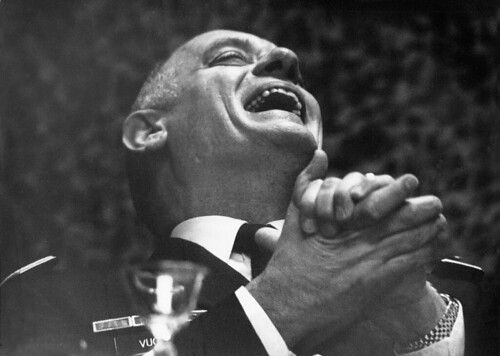
U.S. Army Gen. Carl E. Vuono photographed in 1991 in his Monongahela hometown in an image produced, grain and scratches included, in a newspaper darkroom before the digital age overshadowed the process. (Scott Beveridge/Observer-Reporter)
By Scott Beveridge
WEBSTER, Pa. – This morning I awoke from a sweet dream thinking about a female coworker and not in "that" sort of way if kinky images are popping into your mind.
This dream involves the many years I spent working in a photographic darkroom, and it reminded me of a recent conversation I had about that outdated job with Christie Campbell, a fellow photographer at our local newspaper.
She remarked in the office when that subject came up a few months ago about how much she enjoyed the work, while, I said I didn't miss being around the smell and touch of the caustic chemicals and time it took to make pictures come to life in the dark.
I was fooling myself, so this dream last night would teach me.
It took me back to 1987 when we were still using cameras to shoot 35mm film to create black and white news and feature images for the Observer-Reporter in Washington, Pa.
The job required us to rush back to the darkroom, wind the film as if blind around a finicky wire-rimmed spool and secure it into a light-sealed canister. Then the sealed film had to be bathed in a developer, stop bath and then fixer chemicals all timed to the begin and end the process in accordance to the speed of the settings on the camera.
Once dry an in a room lit by a dim red bulb, a selected negative would be slid into a bulky enlarger, where a white bulb would project the image from a preselected distance onto photography paper. This skill was needed to correctly make the image's blacks perfectly black and grays the appropriate shades of gray, while also maintaining its white areas crisp white.
If the test run wasn't spot on, we'd use our fingers and hands to block out the light under the enlarger, or dodging instruments we crafted out of a long, straight strand of a wire coat hanger with a round piece of cardboard the shape of a quarter taped to its end. Then the photography paper was run through a similar bath of chemicals to bring a photo to life.
This really was making miracles happen with a magic wand.
And it wasn't the end of the business of getting photos into the daily newspaper for a photographer, like me, whose photos were a 20-minute drive from darkroom to newsroom.
I had to deliver the prints in person to editors, unlike today, when high-quality digital photographs quickly toned on a computer with Photoshop are dropped into their hands within seconds via email or a content management system.
No. I didn't miss those old darkroom days until a dream took me back with a broad sleep-induced smile to my old darkroom in Monongahela, Pa.
In slumber, the photographic chemicals that were there 25 years ago miraculously still worked perfectly.
I was so happy, and making plans to relocate that darkroom to my house to keep it alive, knowing this digital age would kill that way of doing business.
And, then it was time to go to work in the real world and tell Christie Campbell that she was right all along about old-school photographers missing the old way of making still pictures.

1 comment:
I've always wanted to try shooting with film, but I won't until I can learn to develop my images myself. I wonder if Pitt or some other school offers a dark room course? I was a chemist before I was a photographer, so I think I could handle it! :)
Post a Comment